 Plant Summary
Plant Summary
Botanical Name: Crocus bulb hybrids
Type: Flowering
Origin: The corms of hybrids available originate from Asia, Europe and North Africa.
Height: A Crocus will grow up to a height of approximately 20 cm (8 in).
Soil: Any general purpose, good quality potting mix is acceptable for Crocus bulb hybrids.
Light: During their cold treatment, corms need to be kept in the dark. This needs to be followed by accustomising the young plants to brighter conditions (see below). Blooming plants like bright light, but need to be kept out of direct sunlight.
Humidity: Undemanding, the Crocus is happy with average levels of humidity.
 Temperatures: This is one house plant that prefers to be a little cooler - temperatures ranging between 6 and 16 degrees C (40 to 60 degrees F) will encourage blooming for weeks.
Temperatures: This is one house plant that prefers to be a little cooler - temperatures ranging between 6 and 16 degrees C (40 to 60 degrees F) will encourage blooming for weeks.
Water: Until growth emerges, watering should be done sparingly. Once growing, the soil needs to be kept moist evenly. It is vital to check regularly, as these flowering plants tend to be very thirsty.
Fertiliser: From the moment the Crocus is planted until it begins to bloom, the Crocus should be fed once a month with a balanced, diluted (1:1) liquid fertiliser. Fertilising should stop once blooming.
Propagation: Indoors, corms will not bloom more than once, although they may produce offsets (which will mature over a few years). They can, however, be kept and used outside. Once the foliage has died back, they should be stored somewhere dry and cold. In autumn, they can be planted outside and left to the care of Mother Nature. When they are ready, they will bloom.
 Description and Care Tips
Description and Care Tips
Crocus hybrid bulbs are not actually bulbs, but corms. These corms produce masses of gorgeous cup-shaped flowers in a range of colours, including white, yellow, lavender and purple. Some blooms are plain coloured, while others feature stripes. All of them have bright orange stigmas. The leaves of the Crocus are upright, slender and usually striped in green and white.
One of the first flowering plants to herald spring, the Crocus often pops its lovely, colourful blooms through the last remaining layers of snow. Luckily, it is not necessary to wait for spring in order to wait for these lovely blooms, because the Crocus can be forced to flower indoors during mid-winter. The best time to start the forcing process is in October.
 The first step of the forcing procedure is a 12 week cold treatment. Naturally, if pre-chilled corms are purchased, this step can be omitted. To begin, a shallow pot - which needs to be a minimum of 7 cm (3 in) deep - is filled loosely with a good potting mix, leaving enough space to accommodate the corms on top - the tips should end up roughly at the same level as the rim of the pot.
The first step of the forcing procedure is a 12 week cold treatment. Naturally, if pre-chilled corms are purchased, this step can be omitted. To begin, a shallow pot - which needs to be a minimum of 7 cm (3 in) deep - is filled loosely with a good potting mix, leaving enough space to accommodate the corms on top - the tips should end up roughly at the same level as the rim of the pot.
Several corms can then be set closely, but never touching, into the pot with their pointed end facing upwards. They should not be pressed into the soil, as it needs to remain loose enough to allow the roots to grow easily into and through it. The corms are then barely covered with additional soil. While it is tempting to mix Crocuses, it should be noted that different varieties tend to have different flowering periods. It is best to keep each pot to a single variety.
After watering thoroughly and allowing excess liquid to drain off, the pot needs to be moved into a cool - around 4 degrees C (40 degrees F) - and dark spot. A refrigerator, an unheated garage or a basement are ideal, as long as temperatures will not drop to freezing point. They can be kept in the dark by placing another pot, a box or a black bin liner over the pot, but it is necessary to allow for access, as the soil needs to be kept moist throughout this stage.
 Once the shoots reach a height of around 5 cm (2 in), the pot can be moved to a slightly warmer - around 10 degrees C (50 degrees F) place. Light conditions in the new location need to be low to begin with. The little plants can then be accustomised to brighter light by gradually moving them closer to a sunny window over a few days.
Once the shoots reach a height of around 5 cm (2 in), the pot can be moved to a slightly warmer - around 10 degrees C (50 degrees F) place. Light conditions in the new location need to be low to begin with. The little plants can then be accustomised to brighter light by gradually moving them closer to a sunny window over a few days.
To ensure even growth, the pot should be turned every day. When the Crocus is in full bloom, it needs to be in a bright place, but out of direct sunlight. This, and keeping temperatures comparatively cool (see above) will prolong the blooming period substantially.
 This list includes a selection of common, not quite so common and unusual house plants beginning with the letters 'D' and 'E'. If the name of a plant is not known - sometimes well meaning friends remove details before giving a plant as a present because the price happens to be on the label - it may be possible to first of all identify it by taking a peek at the images shown in the Green Thumb Photo Album.
This list includes a selection of common, not quite so common and unusual house plants beginning with the letters 'D' and 'E'. If the name of a plant is not known - sometimes well meaning friends remove details before giving a plant as a present because the price happens to be on the label - it may be possible to first of all identify it by taking a peek at the images shown in the Green Thumb Photo Album. 



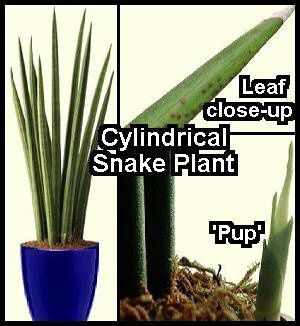 Plant Summary
Plant Summary  Humidity: Average humidity levels are required for the Cylindrical Snake Plant, although it will tolerate dry air to a certain extent. It should, however, be kept well away from drafts and/ or air vents.
Humidity: Average humidity levels are required for the Cylindrical Snake Plant, although it will tolerate dry air to a certain extent. It should, however, be kept well away from drafts and/ or air vents.  Propagation: Like all Snake Plants, this species can be propagated by separating its offsets - known as pups - growing from the parent's base. Dividing this plant is easy enough: after turning the pot onto its side, the plant is eased out carefully. The pups can then be cut off the parent plant using a sharp, serrated knife and planted into their own containers.
Propagation: Like all Snake Plants, this species can be propagated by separating its offsets - known as pups - growing from the parent's base. Dividing this plant is easy enough: after turning the pot onto its side, the plant is eased out carefully. The pups can then be cut off the parent plant using a sharp, serrated knife and planted into their own containers.  Related to the Mother-in-Law's Tongue - and just as carefree and easy to grow - this plant has a bold, fresh style that will add a striking accent to a collection of house plants. Because Sansevieria cylindrical is so easy going and highly tolerant of both dry air and dry soil, it lends itself perfectly as an office plant.
Related to the Mother-in-Law's Tongue - and just as carefree and easy to grow - this plant has a bold, fresh style that will add a striking accent to a collection of house plants. Because Sansevieria cylindrical is so easy going and highly tolerant of both dry air and dry soil, it lends itself perfectly as an office plant.  Plant Summary
Plant Summary  Description and Care Tips
Description and Care Tips  Poor ventilation and wet soil may encourage the growth of a fuzzy, grey fungus called botrytis. This fungus is capable of very quickly killing off the plant. Affected leaves therefore need to be removed as soon as the first signs of an infection - brown patches on yellowing leaves - appear. Plants that are very badly affected may need to be discarded completely.
Poor ventilation and wet soil may encourage the growth of a fuzzy, grey fungus called botrytis. This fungus is capable of very quickly killing off the plant. Affected leaves therefore need to be removed as soon as the first signs of an infection - brown patches on yellowing leaves - appear. Plants that are very badly affected may need to be discarded completely. 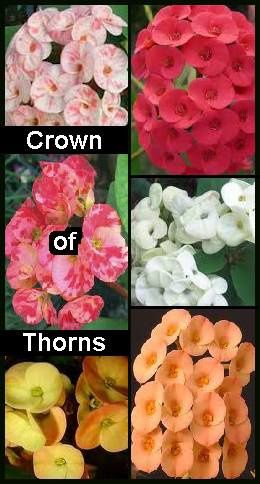 Plant Summary
Plant Summary  Water: The top 2.5 cm (1 in) of the potting mix should be allowed to dry out between watering sessions. To prevent this house plant from rotting, it is important to avoid getting its stems and leaves wet. During the plant's resting period in the winter months, watering should be reduced to a bare minimum.
Water: The top 2.5 cm (1 in) of the potting mix should be allowed to dry out between watering sessions. To prevent this house plant from rotting, it is important to avoid getting its stems and leaves wet. During the plant's resting period in the winter months, watering should be reduced to a bare minimum.  Description and Care Tips
Description and Care Tips  Easy to grow and comparatively drought tolerant, these house plants prefer to live in sandy, slightly dry soil. Because they store water within their thick stems, they do not need to be watered as often as other house plants. Watering should be reduced if the leaves begin to turn yellow and/ or fall off.
Easy to grow and comparatively drought tolerant, these house plants prefer to live in sandy, slightly dry soil. Because they store water within their thick stems, they do not need to be watered as often as other house plants. Watering should be reduced if the leaves begin to turn yellow and/ or fall off. 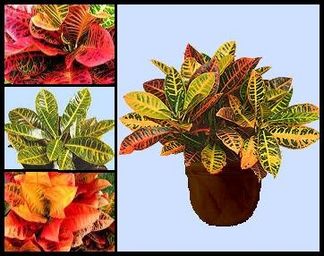 Plant Summary
Plant Summary  Temperatures: Crotons like to be kept reasonably warm. Temperatures ranging from 18 to 29 degrees C (65 to 85 degrees F) are ideal.
Temperatures: Crotons like to be kept reasonably warm. Temperatures ranging from 18 to 29 degrees C (65 to 85 degrees F) are ideal.  Description and Care Tips
Description and Care Tips  Until the Croton gets to the desired size, it should be repotted in spring, moving up just one container size at the time. Once it has grown to the right size, it can be kept from growing larger by keeping it in the same container and just top dressing it once a year.
Until the Croton gets to the desired size, it should be repotted in spring, moving up just one container size at the time. Once it has grown to the right size, it can be kept from growing larger by keeping it in the same container and just top dressing it once a year.  Plant Summary
Plant Summary  Temperatures: This is one house plant that prefers to be a little cooler - temperatures ranging between 6 and 16 degrees C (40 to 60 degrees F) will encourage blooming for weeks.
Temperatures: This is one house plant that prefers to be a little cooler - temperatures ranging between 6 and 16 degrees C (40 to 60 degrees F) will encourage blooming for weeks.  Description and Care Tips
Description and Care Tips  The first step of the forcing procedure is a 12 week cold treatment. Naturally, if pre-chilled corms are purchased, this step can be omitted. To begin, a shallow pot - which needs to be a minimum of 7 cm (3 in) deep - is filled loosely with a good potting mix, leaving enough space to accommodate the corms on top - the tips should end up roughly at the same level as the rim of the pot.
The first step of the forcing procedure is a 12 week cold treatment. Naturally, if pre-chilled corms are purchased, this step can be omitted. To begin, a shallow pot - which needs to be a minimum of 7 cm (3 in) deep - is filled loosely with a good potting mix, leaving enough space to accommodate the corms on top - the tips should end up roughly at the same level as the rim of the pot.  Once the shoots reach a height of around 5 cm (2 in), the pot can be moved to a slightly warmer - around 10 degrees C (50 degrees F) place. Light conditions in the new location need to be low to begin with. The little plants can then be accustomised to brighter light by gradually moving them closer to a sunny window over a few days.
Once the shoots reach a height of around 5 cm (2 in), the pot can be moved to a slightly warmer - around 10 degrees C (50 degrees F) place. Light conditions in the new location need to be low to begin with. The little plants can then be accustomised to brighter light by gradually moving them closer to a sunny window over a few days.  Plant Summary
Plant Summary  Water: From early spring until the end of autumn, the soil should be kept slightly moist. Watering should be reduced for the winter months.
Water: From early spring until the end of autumn, the soil should be kept slightly moist. Watering should be reduced for the winter months.  One of the main things to remember when caring for this house plant is to make sure it does not get over-watered. The top of the potting mix should be allowed to dry out approximately 2.5 cm (1 in) deep before watering thoroughly. Obviously, adequate drainage is essential to prevent the soil from becoming soggy, which may cause the plant to rot. In winter, watering should be reduced to a bare minimum, just stopping the soil from drying out completely.
One of the main things to remember when caring for this house plant is to make sure it does not get over-watered. The top of the potting mix should be allowed to dry out approximately 2.5 cm (1 in) deep before watering thoroughly. Obviously, adequate drainage is essential to prevent the soil from becoming soggy, which may cause the plant to rot. In winter, watering should be reduced to a bare minimum, just stopping the soil from drying out completely.  The beauty of Creeping Figs can be shown off in various ways. This house plant looks excellent spilling out of a hanging basket, for instance. Another option is to allow the aerial roots to grip onto a topiary, trellis or moss support. It usually helps to initially tie them loosely to the intended support with soft florist's wire. How the Creeping Fig will look is really only limited by its owner's imagination.
The beauty of Creeping Figs can be shown off in various ways. This house plant looks excellent spilling out of a hanging basket, for instance. Another option is to allow the aerial roots to grip onto a topiary, trellis or moss support. It usually helps to initially tie them loosely to the intended support with soft florist's wire. How the Creeping Fig will look is really only limited by its owner's imagination.  Plant Summary
Plant Summary  Humidity: Humidity levels need to be moderate to high for this house plant. A wet pebble tray or a room humidifier should help to raise levels adequately.
Humidity: Humidity levels need to be moderate to high for this house plant. A wet pebble tray or a room humidifier should help to raise levels adequately.  Description and Care Tips
Description and Care Tips 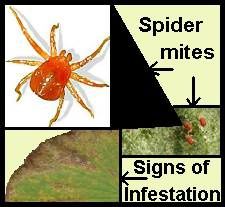 Barely visible to the naked eye, spider mites can do extensive damage to the leaves of plants, typically appearing as brown or yellow spots. If not treated, the plant may eventually stop growing and die. Normal pesticides are likely to make matters worse, as the spider mites are resistant to them, and only bugs that might eat them will be killed off. Spraying the plant using a nozzled hose is often enough to knock of the mites, but if all else fails, dormant, horticultural or insecticidal oil (such as, for instance, neem oil) should work. Miticides will also kill spider mites.
Barely visible to the naked eye, spider mites can do extensive damage to the leaves of plants, typically appearing as brown or yellow spots. If not treated, the plant may eventually stop growing and die. Normal pesticides are likely to make matters worse, as the spider mites are resistant to them, and only bugs that might eat them will be killed off. Spraying the plant using a nozzled hose is often enough to knock of the mites, but if all else fails, dormant, horticultural or insecticidal oil (such as, for instance, neem oil) should work. Miticides will also kill spider mites. 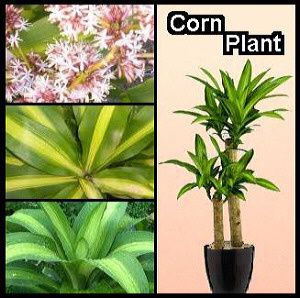 Plant Summary
Plant Summary  Light: Although it usually prefers bright light, this house plant will tolerate low light conditions if need be.
Light: Although it usually prefers bright light, this house plant will tolerate low light conditions if need be.  Description and Care Tips
Description and Care Tips  If Dracaena fragrans gets too tall, it can be pruned back in spring/ early summer. The cane may be cut off at any desired height - it will simply grow new leaves from wherever the cut was made. The stem tip cuttings can be used for propagation if desired.
If Dracaena fragrans gets too tall, it can be pruned back in spring/ early summer. The cane may be cut off at any desired height - it will simply grow new leaves from wherever the cut was made. The stem tip cuttings can be used for propagation if desired.  Plant Summary
Plant Summary 
 Description and Care Tips
Description and Care Tips  If the flower buds drop off, the plant may be exposed to drafts or air that is too cold. Though it likes to be kept cool, it does not appreciate temperatures below 7 degrees C (45 degrees F).
If the flower buds drop off, the plant may be exposed to drafts or air that is too cold. Though it likes to be kept cool, it does not appreciate temperatures below 7 degrees C (45 degrees F).